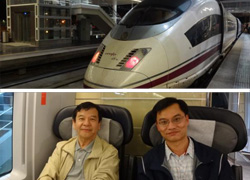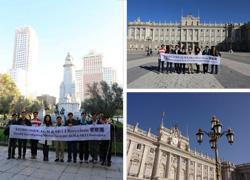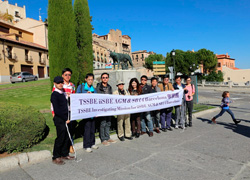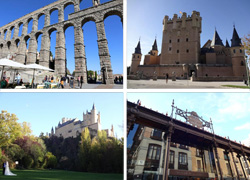Summary of SB14 Barcelona & iiSBE AGM (Part: 6)
 The cultural survey team members headed to the Palau Musica Catalana and Casa Mila. The former was constructed during 1905~1908 by contemporary master Lluis Domenech i Montaner, and now it is used as a concert hall by the Patronato-Orquesta Cludad de Barcelona. The red brick facade of the architecture is adorned by colorful mosaics and the sculptures by Miquel Blay in the corners. The interior exuberates with sheer opulence, especially the massive stained glass dome on top of the performance hall, which emanates radiance as if it is a giant jewelry. When the visitors are inside the hall, they can also hear the extravagant sound of the pipe organ. Casa Mila on Las Ramblas Boulevard is another building designed by Gaudi featuring parabolic brick arches of varying height with spine-like rib structure, uniquely shaped ventilation towers and irregularly shaped atrium, even the meticulous furniture arrangement deserve to be finely appreciated. The team members were profoundly impressed with Gaudi’s avant-garde art and architectural vision. The cultural survey team members headed to the Palau Musica Catalana and Casa Mila. The former was constructed during 1905~1908 by contemporary master Lluis Domenech i Montaner, and now it is used as a concert hall by the Patronato-Orquesta Cludad de Barcelona. The red brick facade of the architecture is adorned by colorful mosaics and the sculptures by Miquel Blay in the corners. The interior exuberates with sheer opulence, especially the massive stained glass dome on top of the performance hall, which emanates radiance as if it is a giant jewelry. When the visitors are inside the hall, they can also hear the extravagant sound of the pipe organ. Casa Mila on Las Ramblas Boulevard is another building designed by Gaudi featuring parabolic brick arches of varying height with spine-like rib structure, uniquely shaped ventilation towers and irregularly shaped atrium, even the meticulous furniture arrangement deserve to be finely appreciated. The team members were profoundly impressed with Gaudi’s avant-garde art and architectural vision. After assembling at the rally point, the entourage headed for Barcelona’s Sants Estacion and boarded the AVE, which departed on time at 18:00 and sped towards the Puerta de Atocha at 300km/h. The team arrived in their destination at 21:10 and traveled to the Husa Princesa hotel. After assembling at the rally point, the entourage headed for Barcelona’s Sants Estacion and boarded the AVE, which departed on time at 18:00 and sped towards the Puerta de Atocha at 300km/h. The team arrived in their destination at 21:10 and traveled to the Husa Princesa hotel.  The primary objective of the survey on October 31, 2014 was Segovia, a city 95km northwest of Madrid. In light of convenience, the team visited the Palacio Real de Madrid by crossing Plaza de Espana early in the morning. The palace’s architectural style is a fusion of Baroque and Neoclassicism, and it also represents the iconic architecture from the prime of the Spanish royalty at the time. The remarkable, exquisite interior design of the palace is best exemplified by the Salon de Trono, which was used by the King for formal receptions. The Salon de Columnas was where the Spaniards signed to join the European Community. The primary objective of the survey on October 31, 2014 was Segovia, a city 95km northwest of Madrid. In light of convenience, the team visited the Palacio Real de Madrid by crossing Plaza de Espana early in the morning. The palace’s architectural style is a fusion of Baroque and Neoclassicism, and it also represents the iconic architecture from the prime of the Spanish royalty at the time. The remarkable, exquisite interior design of the palace is best exemplified by the Salon de Trono, which was used by the King for formal receptions. The Salon de Columnas was where the Spaniards signed to join the European Community.  Segovia is located on a highland 1,000m above sea level; due to its superior strategic position, it was favored by previous monarchs. Segovia was an important city of Kingdom of Castile in the 15th century. In 1474, Queen Isabella of Castile was crowned here, and her castle Alcazar is allegedly the source of inspiration for Disney’s film “Snow White”. The most splendid building inside the castle is the World Heritage Site of Acueducto Romano, which was built 100 BC using granite. The ancient Roman relic is nearly 800m long and features 166 arches; it is supported by 120 pillars with the highest point being 28.9m tall. During construction, no adhesive or tenon was used, as it was stacked up with layers of slates. At the time, it shouldered the responsibility of introducing river water from nearby mountains into the city, and river flowed through the aqueduct up till 1884. The team enjoyed local delicacy Cochinillo Asado (roasted suckling pig) at the century-old restaurant Meson de Candido next to the Acueducto Romano. After lunch, they toured the ancient city on foot, including Plaza Mayor, Catedral and Alcazar. Segovia is located on a highland 1,000m above sea level; due to its superior strategic position, it was favored by previous monarchs. Segovia was an important city of Kingdom of Castile in the 15th century. In 1474, Queen Isabella of Castile was crowned here, and her castle Alcazar is allegedly the source of inspiration for Disney’s film “Snow White”. The most splendid building inside the castle is the World Heritage Site of Acueducto Romano, which was built 100 BC using granite. The ancient Roman relic is nearly 800m long and features 166 arches; it is supported by 120 pillars with the highest point being 28.9m tall. During construction, no adhesive or tenon was used, as it was stacked up with layers of slates. At the time, it shouldered the responsibility of introducing river water from nearby mountains into the city, and river flowed through the aqueduct up till 1884. The team enjoyed local delicacy Cochinillo Asado (roasted suckling pig) at the century-old restaurant Meson de Candido next to the Acueducto Romano. After lunch, they toured the ancient city on foot, including Plaza Mayor, Catedral and Alcazar. |

